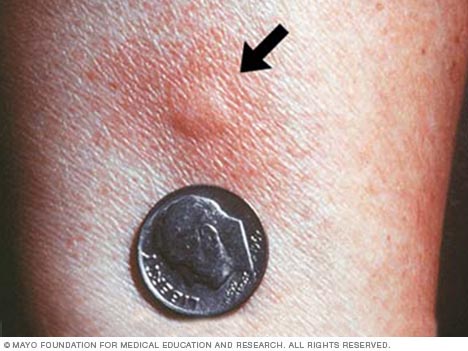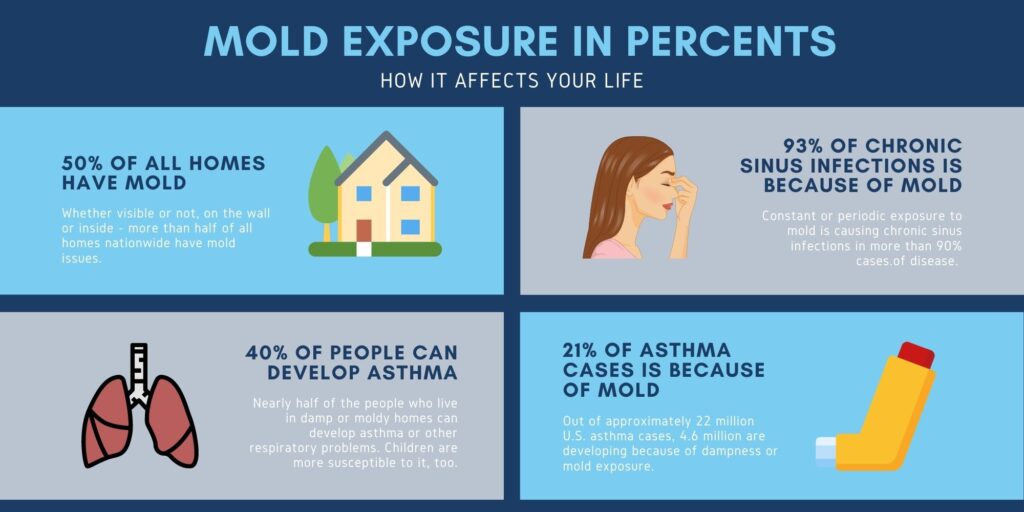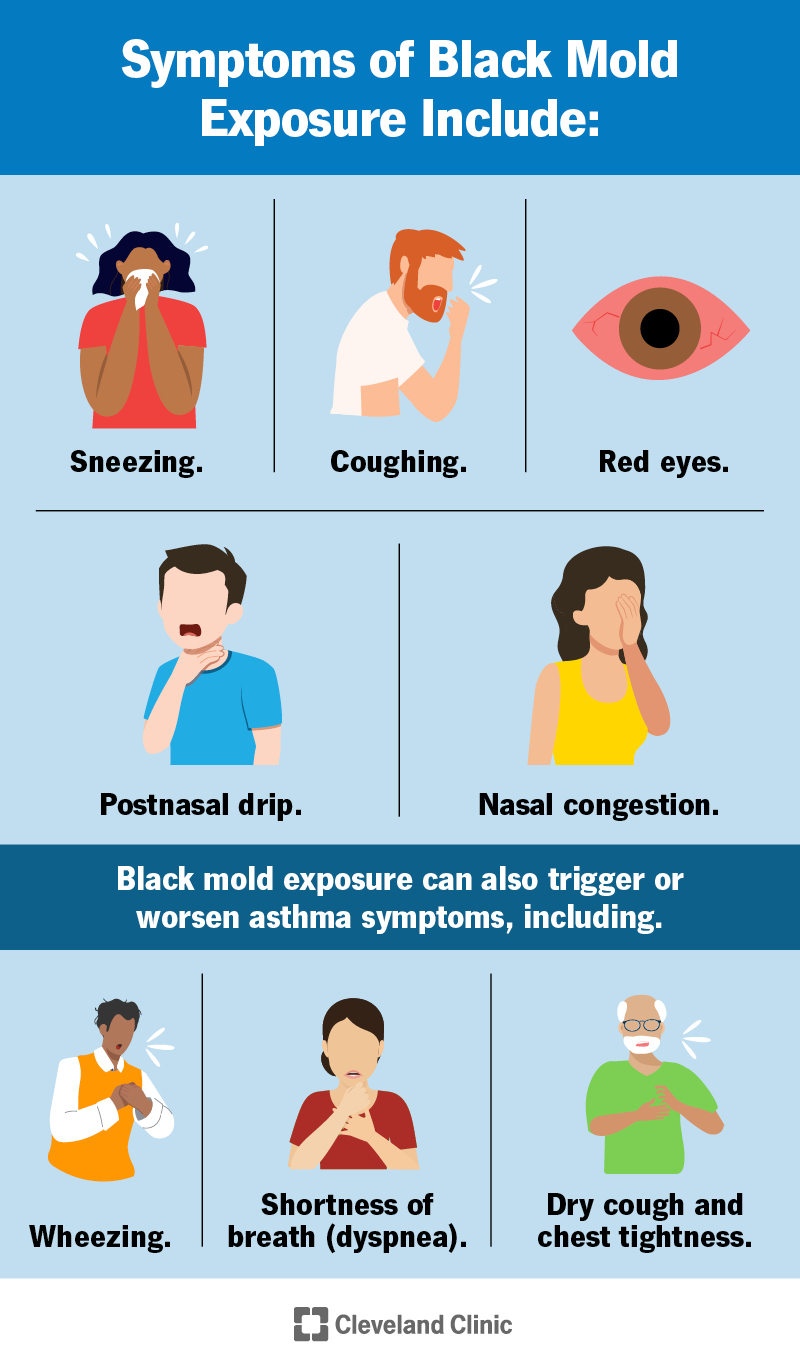In this article, you will discover valuable insights and receive expert advice on the Symptoms of Mold Exposure Mayo Clinic. Uncover the medical knowledge and guidance that can help you better understand the potential health risks associated with mold exposure. From identifying common symptoms to exploring treatment options, this informative resource aims to provide you with the necessary information to navigate any concerns related to mold exposure.
What is Mold Exposure
Mold exposure refers to the condition when individuals come into contact with mold spores, which are tiny reproductive cells released by different types of fungi. These spores can be inhaled or ingested, leading to a range of health issues. Mold exposure is a common problem that can occur both indoors and outdoors, and it can affect people of all ages.
Definition of Mold Exposure
Mold exposure is the term used to describe the process of coming into contact with mold spores. When these spores are inhaled or ingested, they can cause various symptoms and health problems. Mold exposure can occur in various settings, including homes, offices, schools, and other indoor and outdoor environments.
Common Sources of Mold Exposure
Mold can grow in damp and humid environments and can be found both indoors and outdoors. Some common sources of mold exposure include:
- Damp or wet areas such as basements, bathrooms, and kitchens
- Areas affected by water damage, such as leaking pipes or roofs
- Poorly ventilated spaces where moisture can accumulate
- Carpets, upholstery, and fabrics that have been exposed to moisture
- Outdoor areas with high levels of humidity, such as gardens and wooded areas
It is important to be aware of these common sources of mold exposure and take appropriate measures to prevent or address any mold growth.
Understanding the Mayo Clinic
The Mayo Clinic is a renowned medical institution known for its excellence in patient care, research, and education. When it comes to mold exposure, the Mayo Clinic is a trusted source of information and expertise. Their team of healthcare professionals has a deep understanding of the symptoms, diagnosis, and treatment options related to mold exposure.
Symptoms of Mold Exposure
Mold exposure can result in various symptoms that can affect different parts of the body. It is essential to recognize these symptoms to seek appropriate medical attention. Here are some common symptoms of mold exposure:
Nasal and Sinus Symptoms
Mold exposure can lead to nasal congestion, sneezing, runny or itchy nose, and sinus pressure. These symptoms are similar to those caused by seasonal allergies or a common cold, making it important to consider mold exposure as a possible cause.
Respiratory Symptoms
In some cases, mold exposure can cause respiratory symptoms such as coughing, wheezing, shortness of breath, and chest discomfort. These symptoms may indicate an allergic reaction to mold spores or the presence of an underlying respiratory condition.
Skin and Eye Symptoms
Exposure to mold can also manifest in skin irritation, itching, redness, or a rash. Additionally, some individuals may experience eye symptoms like redness, itching, watering, or sensitivity to light.
Neurological Symptoms
Neurological symptoms such as headaches, dizziness, difficulty concentrating, and memory problems have been reported in some individuals exposed to mold. These symptoms can vary in severity and duration.
Digestive Symptoms
Mold exposure may also affect the gastrointestinal system, resulting in symptoms like nausea, vomiting, diarrhea, or abdominal pain. These symptoms can mimic those of food poisoning or other digestive disorders, and it is important to consider mold exposure as a potential cause.
Fatigue and Weakness
Feeling tired, fatigued, or experiencing a general lack of energy is another possible symptom of mold exposure. This fatigue can be accompanied by muscle weakness or joint pain.
Allergic Reactions
Some individuals may experience allergic reactions when exposed to mold, leading to symptoms such as hives, itching, swelling, or anaphylaxis (a severe and potentially life-threatening reaction). Allergic reactions to mold are more likely to occur in individuals with a known allergy to mold or other allergens.
Sensitivity to Mold
Certain individuals may develop an increased sensitivity to mold over time. This means that even low levels of mold exposure can trigger symptoms in these individuals. Sensitivity to mold can lead to more severe symptoms compared to individuals who are not sensitive.
Psychological Symptoms
In some cases, mold exposure can impact mental health and lead to psychological symptoms. These can include mood swings, anxiety, depression, irritability, or difficulty sleeping. It is important to address these symptoms alongside physical symptoms to ensure comprehensive care.
Other Miscellaneous Symptoms
In addition to the symptoms mentioned above, mold exposure has been associated with other miscellaneous symptoms, such as muscle aches, weight loss, increased thirst, or increased urination. These symptoms may vary from person to person and can be influenced by individual factors and the duration and intensity of mold exposure.
Diagnosing Mold Exposure
Diagnosing mold exposure can be challenging as symptoms can overlap with other conditions. However, healthcare professionals can use several approaches to arrive at a diagnosis. Here are some common methods used in diagnosing mold exposure:
Medical History and Physical Examination
The first step in diagnosing mold exposure involves a thorough medical history and physical examination. Healthcare professionals will ask about the individual’s symptoms, potential exposure to mold, and any relevant medical history.
Laboratory Testing
Laboratory testing, such as blood tests or urine tests, can be helpful in some cases. These tests can detect specific antibodies or markers that indicate an allergic or inflammatory response to mold.
Allergy Testing
Allergy testing, including skin prick tests or blood tests, can help identify specific allergens to which an individual may be sensitized. This can help determine if mold is the cause of allergic symptoms.
Biotoxin Testing
In some cases, specialized tests can be conducted to detect mycotoxins, which are toxic substances produced by certain types of molds. These tests are not widely available and may not be necessary for every individual.
Environmental Testing
Environmental testing involves sampling the air or surfaces for the presence of mold spores. This can be done using various methods, including air sampling or surface swabs. Environmental testing can be useful for identifying the presence and type of mold in a particular setting.
Differential Diagnosis
Diagnosing mold exposure requires ruling out other possible causes of symptoms. A healthcare professional will consider other respiratory conditions, allergies, autoimmune diseases, or infectious diseases that may present with similar symptoms.
Treatment and Management
The treatment and management of mold exposure aim to alleviate symptoms, prevent complications, and minimize further exposure. Here are some common approaches used in the treatment and management of mold exposure:
Avoidance of Mold
The most effective way to manage mold exposure is to avoid exposure to mold and its spores. This may involve identifying and addressing the source of mold growth, improving ventilation, using dehumidifiers, and maintaining proper moisture control in indoor environments.
Medications
Medications may be prescribed to relieve specific symptoms caused by mold exposure. Antihistamines can help alleviate allergic symptoms, while nasal sprays or inhalers may be prescribed to manage respiratory symptoms.
Immunotherapy
Immunotherapy, also known as allergy shots, may be considered for individuals with allergic reactions to mold. This involves gradually exposing the individual to small amounts of mold allergens to desensitize the immune system.
Environmental Control Measures
Implementing environmental control measures can help reduce the presence of mold in the individual’s surroundings. This may involve professional mold remediation, proper cleaning and drying techniques, as well as regular maintenance to prevent future mold growth.
Supportive Measures
Supportive measures such as rest, hydration, and healthy lifestyle choices can play a role in managing the symptoms of mold exposure. Getting adequate sleep, eating a balanced diet, and managing stress can contribute to overall well-being.
Follow-up and Prevention
Regular follow-up appointments with a healthcare professional can help monitor the individual’s progress and adjust treatment strategies if needed. Preventive measures, such as maintaining good indoor air quality and addressing any signs of moisture or mold growth promptly, are essential to prevent future exposure.
When to Seek Medical Help
It is important to seek medical help if you experience persistent or worsening symptoms associated with mold exposure. Additionally, severe allergic reactions, concerns about mold exposure, or difficulties with diagnosis or treatment should prompt a consultation with a healthcare professional.

Complications and Associated Conditions
Mold exposure can lead to various complications and associated conditions. It is important to be aware of these potential outcomes to ensure timely medical intervention. Here are some complications and associated conditions related to mold exposure:
Asthma
Exposure to mold can trigger or worsen symptoms of asthma in individuals with the condition. Asthma is a chronic respiratory condition characterized by airway inflammation and constriction, leading to coughing, wheezing, chest tightness, and difficulty breathing.
Sinus Infections
Mold exposure can increase the risk of developing sinus infections. Chronic sinusitis, an inflammation of the sinuses, can cause symptoms such as nasal congestion, facial pain, headache, and postnasal drip.
Fungal Infections
In rare cases, mold exposure can lead to fungal infections, especially in individuals with weakened immune systems. These infections can affect various parts of the body, including the lungs, skin, sinuses, and nails.
Mold-Induced Hypersensitivity Pneumonitis
Some individuals may develop a condition known as hypersensitivity pneumonitis as a result of mold exposure. This is an allergic reaction in the lungs that can cause symptoms such as cough, shortness of breath, fever, and fatigue.
Preventing Mold Exposure
Preventing mold exposure is key to maintaining a healthy indoor environment and preventing associated health issues. Here are some preventive measures that can help minimize mold growth and exposure:
Home Maintenance and Repair
Regularly inspecting and maintaining your home is crucial to prevent mold growth. Addressing any leaks, water damage, or plumbing issues promptly can help prevent the conditions necessary for mold growth.
Moisture Control
Controlling moisture levels in your home is essential to prevent mold growth. Keep humidity levels below 50% by using dehumidifiers, properly ventilating bathrooms and other high-moisture areas, and promptly drying any wet surfaces or materials.
Proper Ventilation
Proper ventilation is key to preventing mold growth. Ensure that your home has adequate ventilation in areas such as kitchens, bathrooms, and laundry rooms. Use exhaust fans or open windows when cooking, showering, or doing laundry.
Cleaning and Drying
Regular cleaning and drying of surfaces, fabrics, and carpets can help prevent mold growth. Clean any visible mold promptly using appropriate cleaning products, and ensure that all surfaces are thoroughly dried after cleaning or any water-related activities.

Who is at Risk
While anyone can be exposed to mold, certain individuals are more susceptible to the health effects of mold exposure. Here are some groups that may be at higher risk:
Individuals with Allergies or Asthma
People with pre-existing allergies or asthma may be more sensitive to mold spores and may experience more severe symptoms when exposed.
Immunocompromised Individuals
Individuals with weakened immune systems, such as those with HIV/AIDS, undergoing chemotherapy, or taking immunosuppressive medications, are at a higher risk of developing complications from mold exposure.
Occupational Exposures
Certain occupations, such as farming, construction, or mold remediation, may involve a higher risk of mold exposure due to the nature of the work. Proper personal protective equipment and safety measures should be implemented to minimize exposure.
Poor Indoor Air Quality
Living or working in environments with poor indoor air quality, such as buildings with water damage or inadequate ventilation, can increase the risk of mold exposure. Those residing in older or poorly maintained buildings may be at higher risk.
Understanding Mayo Clinic’s Expertise
The Mayo Clinic is a leading institution when it comes to research, diagnosis, and treatment of mold exposure. Here are some key aspects of the Mayo Clinic’s expertise in this area:
Leaders in Mold Exposure Research
The Mayo Clinic has a dedicated team of researchers who are actively involved in studying mold exposure and its health effects. Their research contributes to a better understanding of the condition and guides treatment options.
Specialized Diagnostic Tools
The Mayo Clinic utilizes state-of-the-art diagnostic tools and techniques to accurately diagnose mold exposure. These tools may include specialized laboratory testing, advanced imaging techniques, and environmental sampling.
Multidisciplinary Approach
The Mayo Clinic takes a multidisciplinary approach to the diagnosis and treatment of mold exposure. Their team consists of various medical specialists, including allergists, pulmonologists, dermatologists, and more, who collaborate to provide comprehensive care.
Patient Education and Support
The Mayo Clinic emphasizes patient education and support. Their healthcare professionals take the time to educate patients about mold exposure, its symptoms, preventive measures, and treatment options. They also provide necessary support and resources to help individuals manage their condition.
Collaboration with Environmental Health Specialists
The Mayo Clinic collaborates with environmental health specialists to address the environmental aspects of mold exposure. This collaborative approach ensures a comprehensive understanding of the condition and effective management strategies.

When to Consult a Healthcare Professional
It is important to consult a healthcare professional in certain situations related to mold exposure. Here are some instances when seeking medical help is recommended:
Persistent or Worsening Symptoms
If you experience symptoms associated with mold exposure that persist or worsen over time, it is important to seek medical help for proper evaluation and management.
Severe Allergic Reactions
If you develop severe allergic reactions, such as difficulty breathing, swelling, or anaphylaxis, after exposure to mold, immediate medical attention is necessary. Severe allergic reactions can be life-threatening and require prompt treatment.
Concerns about Mold Exposure
If you have concerns about mold exposure or suspect that mold may be present in your environment, consulting a healthcare professional can provide you with the necessary guidance and appropriate testing.
Difficulties with Diagnosis or Treatment
If you have difficulties with the diagnosis or treatment of mold exposure, seeking a second opinion or consulting a specialist, such as an allergist or environmental medicine physician, can be beneficial in obtaining a comprehensive evaluation and finding effective treatment options.
Conclusion
Mold exposure is a common problem that can have a wide range of symptoms and health effects. It is important to recognize the symptoms of mold exposure and seek appropriate medical attention. The Mayo Clinic is a trusted source of expertise in this field, offering comprehensive diagnosis, treatment, and preventive measures. By understanding the symptoms, diagnosis, and treatment options for mold exposure, individuals can take proactive steps to manage their health and prevent future exposure.

